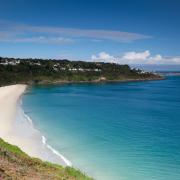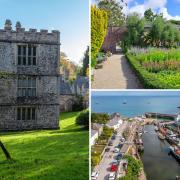Award-winning photographer David Chapman continues to explore Cornwall’s Areas of Outstanding Natural Beauty with a visit to Carnewas to Stepper Point

The Carnewas to Stepper Point AONB takes in Bedruthan Steps at its southern end, follows the coast past Porthcothan, Treyarnon and Constantine Bay, around Trevose Head, Harlyn Bay and Trevone Bay, and ends at the mouth of the Camel Estuary where it takes in Stepper Point and Hawkers Cove.
In May Cornwall Wildlife Trust Photographic Group (CWTPG) was due to host a congress of the International Federation of Wildlife Photographers (IFWP).
The IFWP has a congress in a different European country every year and for the past dozen or so years members of CWTPG have attended these congresses. In fact CWTPG is the only group in the UK to be members of the IFWP, this means that the only British residents allowed to take part in IFWP events are the members of Cornwall Wildlife Trust! This year we decided it was time to invite our European friends to enjoy the wonders of Cornwall so last year we started making plans.

We chose to host the event in May because the coastline of Cornwall always looks so beautiful with thrift and other flowers adding colour to our already wonderful scenery. We set up a small committee and one of the most difficult tasks we undertook was to decide where to take our visitors for three days out. One area we chose was the Carnewas to Stepper Point AONB and last May we had a day in the area looking for the best bits to visit.
We began with a morning visit to Park Head. Parking at Pentire Farm National Trust car park we walked down the valley to Porth Mear, around Park Head and back to the car park from Pentire Steps.
This was my first visit to Porth Mear and I was struck by how beautiful it is in spring, with plenty of bluebells on the coast. The valley is a lovely tranquil spot, an oasis of lush vegetation with a good variety of birds including a Cetti’s warbler as well as sedge warblers, whitethroats, bullfinches and more. It was warm and sunny on the day of our visit so we saw plenty of butterflies including orange-tip, brown argus and common blues.

In the afternoon we headed up the coast to Trevose Head where we photographed the carpet of sea campion and thrift on the track to the lighthouse. The view of Trevose lighthouse from across the unfortunately named ‘Stinking Cove’ is always worth a photograph, especially on a stormy day or with a neutral density filter for a long exposure.
The short walk to the headland at Merrope Rocks brings with it a classic view of Padstow Lifeboat Station. A wide-angle lens is needed to get the lifeboat house, Mother Ivey’s Bay and some foreground flowers in shot and I would recommend a neutral density filter to increase the exposure time. One of the effects of the increased exposure time is to flatten out the sea, enhance its colour and remove texture; this isn’t always a good thing but it can reduce the complexity of an image which has a lot of competing features.
Around Merrope Rocks there are breeding seabirds including shags and fulmars, both of which can be photographed. The fulmars nest on the cliffs behind the lifeboat station and frequently soar around. Peregrine falcons are regular and the fields close to the road are good for corn buntings, in fact this is probably the best place in Cornwall to see this scarce species.

We made it to Carnewas just before closing time to get some tea and cake at the National Trust tea room. This gave us sustenance to continue through until sunset on the cliffs overlooking Bedruthan Steps. In previous years I have concentrated my photographic efforts on the coastal section to the north of Bedruthan Steps but a large section of that coast path has literally disappeared into the sea, so last year we spent our time near Carnewas where the thrift was incredible.
Looking at my photos there are two things I would criticise about my efforts. I was concentrating hard on filling the foreground with the flowers of the thrift, so I used a wide-angle lens and got quite close to the flowers. By getting too low I have included less of the beach than I really wanted to. Maybe I would have been better taking the same photo with a lower tide or maybe I should have lifted the camera a little higher.
The other, less easily resolved, problem is that Park Head, which features in the background to my photos, is cast into shade at sunset in May. Despite these minor difficulties I am sure we will be taking our European friends to Bedruthan for a sunset, it is staggeringly beautiful, so let’s hope the thrift will be as impressive this year as it was last.






























